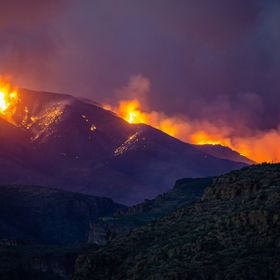
Monsoon in the desert is both breathtaking and powerful.
Monsoon in the desert is both breathtaking and powerful.
Read less
Read less
Views
716
Likes
Awards
Legendary Award
Absolute Masterpiece
Superb Composition
Top Choice
Superior Skill
Outstanding Creativity
Peer Award
Magnificent Capture
Jaw Dropping
Top Ranks
Categories
Same photographer See allBehind The Lens
Discover more photos See all
Behind The Lens
Location
This image was captured on the Eastern Edge of Phoenix AZ, looking Northeast. Pictured is the 4 Peaks Wilderness area, with some housing in the foreground. The bolt of lightning is touching down at the base of 4 peaks, which is obscured by the rain curtain on the left side of the image.Time
This was taken in the blue hour in July of 2013, about 8 PM local time. I was shooting longer exposures to try and catch some lightning but there was still enough light to get decent foreground images and not blow them out.Lighting
The lighting in this photo is all ambient. It's a 4 second exposure on a crop sensor, so fading daylight and additional illumination from the lightning strike are the lighting sources.Equipment
This image was captured with a Nikon D7000 and a Sigma 18-200 f/4.5 telephoto. My tripod is a hand-me-down of unknown maker and 1960's vintage.Inspiration
I love chasing storms. The constant changes in lighting and color from the clouds, rain, lightning, and occasional funnel clouds make for an ever-changing and landscape, and I live for the hunt.Editing
Landscape photos in lower lighting conditions always need some kind of post-processing. You always have to blend bright skies with darker foregrounds, which usually involves multiple exposures or processing the same raw files at different brightness levels and then combining them to get a nicely exposed whole. In this case, however, I really wanted to emphasize the lightning so I used that as my white balance point and did some exposure and color corrections in lightroom based off of that. Additional tuning in photoshop for sharpness and some dust spot removal and a watermark, and this one was finished.In my camera bag
My Lowepro bag is always ready to go with my D7000, usually mounted with a Sigma 18-200 that is my main "walking around" lens. I also carry Nikkor 35 and 50mm primes for specific lighting situations. A Rokinon 16mm f/2 lens round out my normal kit, and I use that for landscape and astrophotography sessions. I also have the usual extra batteries, a couple of Vivitar flashes and remote trigger kits, cleaning supplies, a small flashlight with a red colored beam (for astro sessions), a couple of refillable water bottles IR trigger, and spare body mounts for my tripod.Feedback
Capturing Lightning is a lot of trial and error. First and foremost, you need to have storms throwing lightning that you can safely image. Each session will be dirferent depending on the storm and the ambient lighting, and your desired end goal. I try to start at ISO 100, with a 4 second exposure and f/8, and make adjustments to my settings from there based on what the storm is doing. Storms can be very unpredictable and lighting can strike up to 10 miles from an active cell. ALWAYS be aware of your surroundings and make sure you have some place you can safely seek shelter if the storm gets too close or dangerous. Chasing lightning is a lot of fun, but you can be seriously injured if you are not being safe and careful.












































